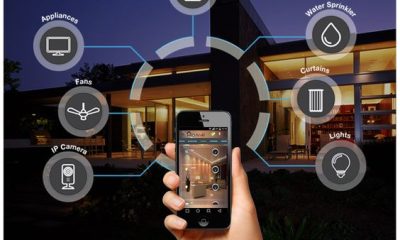Popular
What Is Smart Home Healthcare?

Understanding Smart Home Healthcare: Revolutionizing Healthcare Delivery
Introduction ( What Is Smart Home Healthcare? )
In the era of rapid technological advancements, the way we approach healthcare is undergoing a significant transformation. Smart Home Healthcare is at the forefront of this revolution, reshaping the traditional healthcare landscape. This article delves into the concept of Smart Home Healthcare, its definition, and its profound relevance in today’s world.
What is Smart Home Healthcare?
Smart Home Healthcare, often referred to as connected health or telehealth, is a cutting-edge approach to delivering healthcare services. It leverages the power of technology to provide personalized and remote healthcare solutions within the comfort of one’s home. In essence, it merges healthcare with smart devices, the Internet of Things (IoT), telecommunication, and artificial intelligence (AI) to create an interconnected ecosystem that enhances healthcare accessibility and quality.
Significance and Relevance
The importance of Smart Home Healthcare becomes evident when we consider the evolving healthcare landscape and the challenges it faces. Here are some key reasons why Smart Home Healthcare is of great significance:
1. Aging Population: Many countries are experiencing a growing elderly population, which often requires more frequent healthcare monitoring and assistance. Smart Home Healthcare provides an effective way to address the healthcare needs of aging individuals, enabling them to maintain independence and receive prompt medical attention.
2. Chronic Disease Management: Chronic diseases like diabetes, hypertension, and heart conditions are on the rise. Continuous monitoring and management are vital for patients with chronic illnesses. Smart Home Healthcare enables real-time tracking of health parameters and immediate intervention when necessary
3. Healthcare Access: Rural or underserved areas often lack easy access to healthcare facilities. Smart Home Healthcare bridges this gap by allowing remote consultations and diagnostics, providing healthcare to those who might otherwise struggle to receive it.
4. Pandemic Preparedness: The COVID-19 pandemic highlighted the importance of telehealth and remote monitoring. Smart Home Healthcare offers a robust framework for dealing with similar health crises by reducing physical contact and the spread of contagious diseases.
5. Personalization and Preventive Care: Through data analytics and AI, Smart Home Healthcare can analyze a patient’s health history, lifestyle, and real-time data to offer personalized recommendations and proactive healthcare, thereby preventing potential health issues.
6. Cost-Efficiency: By reducing the need for frequent hospital visits, Smart Home Healthcare can lower healthcare costs for both patients and healthcare systems. It promotes early intervention, which can prevent costly hospitalizations.
7. Enhanced Quality of Life: The convenience of Smart Home Healthcare empowers individuals to take control of their health and well-being, fostering a better quality of life.
In conclusion, Smart Home Healthcare is more than just a technological trend; it’s a healthcare revolution that brings the doctor’s office to your doorstep. It promises to make healthcare more accessible, personalized, and efficient, ultimately improving the lives of individuals and the overall healthcare system. In the following sections of this article, we will explore the key components of Smart Home Healthcare, its benefits, challenges, case studies, future trends, and its implications for the future of healthcare.
II. Key Components of Smart Home Healthcare
Smart Home Healthcare is built on several key components that enable its functionality and effectiveness. These components form the technological infrastructure that supports the delivery of healthcare services in the comfort of one’s home. In this section, we will explore these critical elements:
A. IoT Devices and Sensors
The Internet of Things (IoT) plays a pivotal role in Smart Home Healthcare. IoT devices and sensors are embedded in various healthcare equipment and everyday objects to collect and transmit data. These devices can monitor vital signs, track medication adherence, and detect falls or emergencies. For instance, smart blood pressure monitors, wearable fitness trackers, and smart scales are commonly used IoT devices that seamlessly integrate with the Smart Home Healthcare ecosystem.
B. Health Monitoring and Wearables
Wearable devices are at the forefront of Smart Home Healthcare. Smartwatches, fitness trackers, and medical wearables are equipped with sensors to monitor heart rate, activity levels, sleep patterns, and more. They provide real-time data that can be analyzed to assess an individual’s health and well-being. Wearables have become essential tools for remote health monitoring and preventive care.
C. Telemedicine and Remote Consultations
Telemedicine, or telehealth, is a fundamental component of Smart Home Healthcare. It enables individuals to connect with healthcare providers through video calls, voice calls, or text messages. Telemedicine consultations allow patients to seek medical advice, receive prescriptions, and discuss their health concerns without the need for in-person visits. This is particularly valuable for those with mobility issues, living in remote areas, or during health crises.
D. Data Analytics and AI
Data analytics and artificial intelligence (AI) are the brains behind Smart Home Healthcare. The vast amount of data collected from IoT devices, wearables, and telehealth consultations is processed and analyzed by AI algorithms. AI can identify patterns, detect anomalies, and provide personalized health recommendations. It can predict health trends and flag potential health risks, allowing for early intervention.
These key components work together to create a comprehensive Smart Home Healthcare system that empowers individuals to actively participate in their health management and allows healthcare providers to offer timely and personalized care.
In the next section, we will explore the benefits of Smart Home Healthcare, highlighting how these components contribute to improved healthcare delivery.
III. Benefits of Smart Home Healthcare
Smart Home Healthcare offers a multitude of benefits that revolutionize the way healthcare is delivered and experienced. These advantages extend to both patients and healthcare providers. In this section, we will explore the significant benefits of this innovative approach:
A. Improved Patient Care
1. Personalized Care: Smart Home Healthcare allows for tailored treatment plans based on an individual’s health data, lifestyle, and medical history. This personalized approach enhances the effectiveness of care.
2. Early Detection: Continuous monitoring and AI-driven analytics can detect health issues at their early stages, enabling prompt intervention and preventing the progression of diseases.
3. Enhanced Medication Management: Smart medication dispensers and reminders help patients adhere to their prescribed treatment regimens, reducing medication errors and improving overall health outcomes.
B. Remote Monitoring and Management
1. Continuous Health Tracking: Patients can be monitored around the clock, providing healthcare providers with a comprehensive view of their health status, which is especially critical for those with chronic conditions.
2. Reduced Hospital Readmissions: Remote monitoring helps in identifying deterioration in a patient’s condition, reducing the need for frequent hospital readmissions and associated costs.
3. Access to Specialists: Telemedicine connects patients with specialist healthcare providers, even if they are located far away, ensuring access to the best medical expertise.
C. Cost Savings
1. Lower Healthcare Costs: Smart Home Healthcare reduces the need for hospital stays, emergency room visits, and transportation costs, resulting in overall cost savings for patients and healthcare systems.
2. Efficient Resource Allocation: Healthcare providers can allocate resources more efficiently, focusing on patients who need immediate attention while offering remote care to stable patients.
D. Enhanced Patient Experience
1. Convenience: Patients have the flexibility to receive healthcare services from the comfort of their homes, eliminating the need for time-consuming and often stressful hospital visits.
2. Reduced Wait Times: Telemedicine consultations typically have shorter waiting times compared to in-person appointments, leading to a more pleasant patient experience.
3. Empowerment: Smart Home Healthcare empowers individuals to actively manage their health, fostering a sense of control and autonomy.
These benefits collectively demonstrate how Smart Home Healthcare is reshaping the healthcare landscape, making it more patient-centric, cost-effective, and efficient. In the next section, we will explore the challenges and concerns associated with the implementation of Smart Home Healthcare, highlighting the areas that require attention and improvement to ensure its success.
IV. Challenges and Concerns
While Smart Home Healthcare offers a promising future, its implementation comes with various challenges and concerns that need to be addressed to ensure its success and safety. Here are some of the key issues to consider:
A. Privacy and Security
1. Data Privacy: The vast amount of personal health data collected in Smart Home Healthcare raises concerns about data security and privacy. Safeguarding this information from breaches and unauthorized access is paramount.
2. Cybersecurity: IoT devices and telehealth platforms can be vulnerable to cyberattacks. Protecting the integrity of the system and patient data is essential.
B. Accessibility and Inclusivity
1. Digital Divide: Not everyone has access to the internet or the necessary devices to participate in Smart Home Healthcare. This creates disparities in healthcare access, especially among underserved communities.
2. Aging Population: While Smart Home Healthcare can benefit the elderly, many older individuals may not be familiar with or comfortable using the technology, posing challenges to their adoption.
C. Reliability and Accuracy
1. Technical Issues: Connectivity problems, device malfunctions, or inaccurate readings can undermine the reliability of the system, potentially leading to misdiagnosis or inadequate care.
2. Overreliance on Technology: Patients and healthcare providers should not rely solely on technology. There must be a balance between remote monitoring and in-person healthcare for comprehensive care.
D. Regulatory and Ethical Issues
1. Regulatory Framework: Smart Home Healthcare is a relatively new field, and regulations may lag behind technological advancements. Establishing clear guidelines and standards is essential.
2. Ethical Dilemmas: Ethical questions may arise concerning AI-driven healthcare decisions, patient consent, and the responsibility of healthcare providers when delivering care remotely.
Addressing these challenges is essential for the safe and widespread adoption of Smart Home Healthcare. Solutions should encompass robust cybersecurity measures, improved accessibility, enhanced device reliability, and the development of ethical guidelines.
In the following sections, we will explore real-world case studies of Smart Home Healthcare implementations, the future trends and developments in this field, and conclude by discussing the potential impact of Smart Home Healthcare on the future of healthcare delivery.
V. Case Studies
To better understand the real-world applications and impact of Smart Home Healthcare, let’s delve into some notable case studies showcasing successful implementations:
A. Philips Healthcare
Philips has been at the forefront of Smart Home Healthcare solutions, offering a range of connected devices and platforms. Their telehealth solutions have been used to remotely monitor patients with chronic conditions such as congestive heart failure and chronic obstructive pulmonary disease (COPD). By providing patients with IoT-enabled devices that transmit vital signs and data to healthcare professionals, Philips has demonstrated a significant reduction in hospital readmissions and improved patient outcomes.
B. VA Telehealth Services
The U.S. Department of Veterans Affairs (VA) has implemented robust Smart Home Healthcare initiatives to serve veterans. The VA’s telehealth services offer remote consultations, home-based primary care, and telemonitoring of chronic conditions. These services have not only improved veterans’ access to healthcare but have also reduced travel time and expenses for both patients and the VA.
C. Medtronic’s Remote Monitoring
Medtronic, a leading medical device company, has integrated remote monitoring into its implantable devices such as pacemakers and defibrillators. This innovation allows healthcare providers to receive real-time data on a patient’s heart health, enabling early intervention when necessary. Patients can go about their daily lives with the assurance that their healthcare team is continually monitoring their condition.
These case studies demonstrate the tangible benefits and diverse applications of Smart Home Healthcare in various healthcare settings. The success stories highlight how this approach is improving patient outcomes, reducing healthcare costs, and enhancing access to care.
In the next section, we will explore the future trends and developments in Smart Home Healthcare, providing insights into what we can expect in the coming years.
VI. Future Trends and Developments
The world of Smart Home Healthcare is constantly evolving, driven by technological advancements, changing healthcare needs, and the desire for more efficient and patient-centric care. Here are some of the key future trends and developments in Smart Home Healthcare:
A. Advancements in IoT and AI
1. Smarter and More Interconnected Devices: IoT devices will become even more intelligent and interconnected. They will seamlessly integrate into the daily lives of individuals, providing real-time health data and insights.
2. AI-Driven Predictive Healthcare: Artificial intelligence will play a more significant role in predicting health issues. AI algorithms will analyze vast datasets to identify potential health risks and suggest preventive measures.
B. Integration with Electronic Health Records (EHR)
1. Seamless Data Exchange: Smart Home Healthcare systems will be better integrated with electronic health records, allowing for more efficient sharing of patient data with healthcare providers. This will enable a more comprehensive view of a patient’s health history.
2. Patient Engagement: Patients will have increased access to their health records and will be more actively engaged in their healthcare decisions.
C. Policy and Regulatory Changes
1. Telehealth Regulations: Governments and healthcare regulatory bodies will likely establish clearer and more supportive regulations for telehealth and Smart Home Healthcare, making it easier for healthcare providers to implement these technologies.
2. Reimbursement Models: Healthcare payment models will adapt to accommodate remote and home-based care, ensuring that healthcare providers are adequately compensated for the services they offer.
D. Potential for AI-driven Predictive Healthcare
1. Proactive Health Management: AI will assist individuals in proactively managing their health, providing personalized recommendations for exercise, nutrition, and stress management to prevent health issues.
2. Early Disease Detection: AI will play a crucial role in early disease detection, leading to more successful treatment outcomes and reduced healthcare costs.
These future trends and developments paint an exciting picture of Smart Home Healthcare’s potential. As technology continues to advance and society’s healthcare needs change, Smart Home Healthcare will play an increasingly important role in delivering high-quality, accessible, and efficient healthcare.
In the final section of this article, we will recap the potential of Smart Home Healthcare and discuss its implications for the future of healthcare delivery.
VII. Conclusion
Smart Home Healthcare represents a transformative shift in healthcare delivery. It merges cutting-edge technology with the imperative need for more accessible, patient-centric, and cost-effective healthcare. In this article, we have explored the concept of Smart Home Healthcare, its key components, benefits, challenges, case studies, and future trends.
The potential of Smart Home Healthcare is immense. It offers the promise of better healthcare outcomes, especially for patients with chronic conditions and the elderly. It enables early intervention, reduces healthcare costs, and enhances the patient experience. The convenience and flexibility it provides can empower individuals to take more control of their health.
However, the challenges and concerns surrounding data security, accessibility, and regulatory frameworks must be addressed to ensure the safe and widespread adoption of Smart Home Healthcare. As technology continues to advance, healthcare systems and regulations must evolve in tandem to fully harness the benefits of this approach.
In the years to come, we can expect to see Smart Home Healthcare becoming increasingly integrated into the fabric of healthcare systems, offering predictive and proactive health management, improved data exchange, and more patient engagement. It has the potential to not only improve individual health but also transform the way healthcare is delivered on a global scale.
Smart Home Healthcare is not just a trend; it’s a fundamental shift in how we approach healthcare, emphasizing prevention, personalization, and accessibility. As we embrace this transformative approach, we are on the path to a future where healthcare is not confined to hospitals and clinics but is a part of our daily lives, supporting our well-being and health at every step.






















